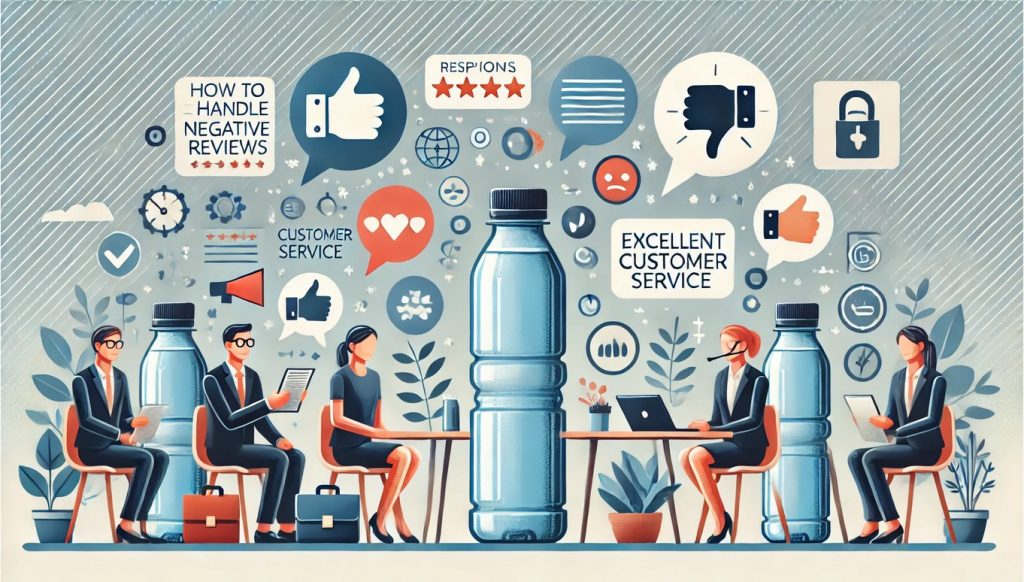The Reality of Negative Reviews
In the highly competitive world of water bottle brands, receiving negative reviews is an inevitable part of doing business. Whether it’s a complaint about the design, functionality, or durability of your product, negative feedback is something every brand must confront at some point. However, the way you respond to these reviews can significantly impact your brand’s reputation, customer loyalty, and long-term success. Ignoring negative reviews or responding defensively can damage your brand, while addressing them constructively can build trust, demonstrate commitment to quality, and foster customer relationships.
While negative reviews may initially seem disheartening, they offer valuable opportunities to gain insights into customer experiences, improve your products, and enhance your business practices.
The Importance of Addressing Negative Reviews
Building Customer Trust Through Transparency
When customers leave negative reviews, they’re often looking for validation, acknowledgment, or resolution. Ignoring these comments or failing to respond can damage your credibility. On the other hand, addressing negative reviews transparently demonstrates that your company is listening, cares about feedback, and is committed to making improvements.
Responding thoughtfully to negative reviews signals to your customers that their voices matter. Acknowledging that mistakes happen or that products sometimes don’t meet expectations builds trust. Consumers appreciate brands that are open about their flaws, as it fosters a sense of authenticity and reliability.
Transparency in handling negative feedback also reassures potential customers who may be hesitant to purchase your water bottles. When they see how you handle criticism, it reassures them that any potential issues will be resolved in a fair and customer-friendly manner.
Turning Negative Feedback into a Positive Experience
When handled properly, negative reviews can provide an opportunity to turn an unhappy customer into a brand advocate. By addressing complaints swiftly and positively, you can show your commitment to customer satisfaction and product quality.
For example, a customer who complains about the design of your water bottle may simply need an alternative product or an explanation regarding how the design was created with certain features in mind. Offering them a solution such as a replacement bottle, a discount, or a personalized response can change their perception of your brand. Customers are more likely to forgive a company that makes an effort to resolve issues, especially when they feel that their concerns are taken seriously.
Moreover, a well-crafted response to a negative review is not only seen by the reviewer but also by future customers browsing your brand’s reviews. A professional, empathetic, and solution-oriented response can enhance your brand’s public image and demonstrate your commitment to customer service.
Improving Product Quality Through Feedback
Negative reviews often highlight areas where your product may be falling short, such as issues with durability, ease of use, or functionality. Listening to these complaints provides valuable insights that can help you improve your product quality.
For example, if many reviews point out that the water bottle’s lid doesn’t seal properly, it could indicate a design flaw that needs to be addressed. By taking feedback seriously and working to resolve these issues in future product batches, you demonstrate your commitment to delivering high-quality products and to continuous improvement.
Incorporating customer feedback into your product development process not only helps improve the quality of your water bottles but also enhances customer loyalty, as consumers feel that their input is valued and appreciated.
Types of Negative Reviews and How to Respond
Complaints About Product Quality
One of the most common types of negative reviews for water bottles relates to product quality. This could include complaints about leaks, difficulty in opening or closing the bottle, poor insulation, or even damage during shipping.
Acknowledge and Apologize
The first step in responding to quality-related complaints is to acknowledge the issue and apologize for the inconvenience caused. Even if the issue was isolated or out of your control, expressing empathy for the customer’s frustration shows that you care about their experience.
For instance, if a customer complains about a water bottle leaking, your response could be:
“We’re really sorry to hear about the issue you encountered with the lid of your water bottle. We understand how frustrating this can be, and we truly appreciate you bringing this to our attention.”
Offer a Solution
After acknowledging the problem, offer a solution. This could involve offering a replacement product, refund, or troubleshooting steps. The key is to resolve the issue in a way that satisfies the customer and shows that you are committed to quality.
Example solution for a leaking bottle:
“We would be happy to send you a replacement lid or a brand-new bottle at no extra cost. Please send us a direct message with your order details, and we’ll take care of it right away.”
Learn from the Feedback
Once you’ve resolved the customer’s complaint, it’s important to evaluate whether this issue is isolated or part of a larger trend. If you start receiving multiple reviews about the same issue, it may be time to assess the production or design process to identify and correct the root cause.
Complaints About Delivery and Shipping
Shipping issues are another common source of negative reviews. Customers might be dissatisfied with the length of delivery time, the condition in which their water bottle arrived, or the cost of shipping.
Apologize for the Inconvenience
Start by offering a sincere apology. Shipping delays or mishandling are often beyond the company’s control, but it’s important to convey that you still take responsibility for the customer’s experience.
Example apology for delayed delivery:
“We’re truly sorry that your order was delayed. We understand how important it is to receive your purchase on time, and we regret that we didn’t meet your expectations on this occasion.”
Provide Clear Communication
If the issue was related to delivery time or damages during shipping, provide clear communication about what went wrong. For example, let the customer know if there were unforeseen delays or if the carrier mishandled the package.
If your company is at fault, offer to make it right by either issuing a refund or providing a replacement. Offering compensation, such as a discount on their next purchase or free shipping, can help improve the overall experience.
Improve Your Shipping Process
In addition to addressing individual complaints, review your shipping practices and work with your logistics partners to identify areas for improvement. Consider upgrading packaging materials to prevent damage or working with carriers that have a better track record for timely deliveries.
Complaints About Customer Service
Occasionally, negative reviews are related to the customer service experience. A customer may feel that their concerns weren’t addressed in a timely manner, or that the support they received was unhelpful or impolite.
Acknowledge the Service Issue
The first step in responding to negative feedback about customer service is to acknowledge the problem and apologize for the customer’s unpleasant experience. It’s important to make it clear that you take customer service seriously and that you are committed to resolving the issue.
Example response to a customer service complaint:
“We sincerely apologize that your experience with our customer service team didn’t meet your expectations. We strive to provide the best service, and it’s clear we missed the mark this time.”
Take Responsibility and Offer a Remedy
After acknowledging the issue, take responsibility for the poor experience and offer a remedy. This could be escalating the issue to a manager, providing additional assistance, or offering a compensation such as a discount or store credit.
For example:
“We would be happy to further investigate your concerns and ensure they are resolved. Please reach out to our customer service manager at [email] for immediate assistance.”
Train Your Customer Service Team
If negative reviews about customer service are frequent, it might be time to evaluate your team’s training and communication protocols. Consider providing ongoing training in areas like communication skills, conflict resolution, and problem-solving to improve customer interactions.
Complaints About Price
Price complaints are common, particularly if customers feel they can find a similar product at a lower price point. Water bottle prices can vary significantly depending on the brand, features, and materials used, so it’s essential to address concerns about price strategically.
Acknowledge the Concern
While price complaints may not always be easy to address, acknowledge the concern and explain the value your product offers. You can remind the customer about the quality, design, or sustainability of your water bottle that justifies the price.
Example response to a price-related complaint:
“We understand that price is an important consideration when purchasing products. Our water bottles are designed with high-quality, eco-friendly materials to ensure durability and performance, which is why we believe they offer great value for the price.”
Emphasize the Long-Term Benefits
Highlight the long-term benefits of investing in your product. For example, a higher-quality water bottle may last longer, reduce the need for single-use plastics, or offer superior functionality compared to cheaper alternatives. Customers who value quality, durability, and environmental sustainability may be more willing to pay a premium price if they understand the long-term advantages.
Complaints About Design or Aesthetics
Water bottles come in many different styles and designs, and what works for one customer might not work for another. Complaints about design could be related to aesthetics, ergonomics, or the bottle’s functionality.
Acknowledge the Personal Preference
Since design is subjective, it’s important to acknowledge that the customer’s preference may differ from your design philosophy. You can empathize with their viewpoint and explain why certain design features were chosen, without being defensive.
Example response to a design complaint:
“We appreciate your feedback on the design of our water bottle. We understand that personal preference plays a big role in product choices, and while we’ve designed this bottle with certain features in mind, we hope that other designs in our range may better suit your needs.”
Suggest Alternatives or Offer a Solution
If possible, suggest alternative products in your lineup that might better meet the customer’s needs. If the customer is dissatisfied with a particular design feature, offer a different bottle style or a customization option.
For example:
“If you’re not satisfied with the color or size of this bottle, we offer several other styles that might be more to your liking. We’d be happy to help you choose the perfect bottle for your needs.”
Handling negative reviews is an essential part of managing your water bottle brand’s reputation. By responding quickly, empathetically, and constructively, you can turn negative feedback into a chance to improve customer satisfaction, enhance product quality, and build a loyal customer base. While it’s impossible to please everyone all the time, your commitment to addressing concerns and making improvements will strengthen your brand and increase customer trust in the long term.







